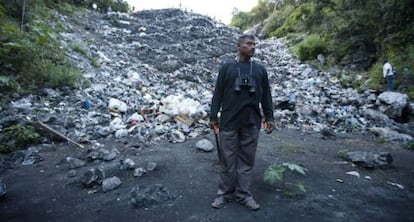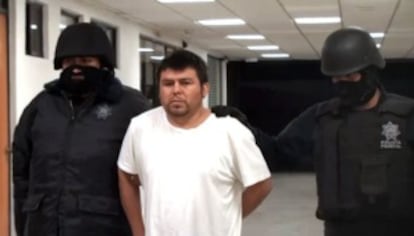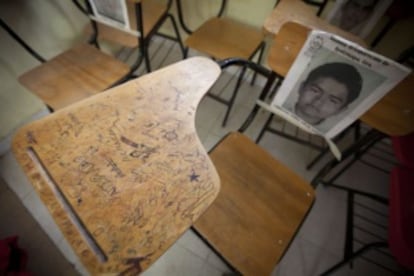“I ordered them to kill the Iguala students and destroy the evidence”
Hit man's confession puts cap on investigation into missing Mexican trainee teachers


Questions concerning the fate of the 43 Mexican youths who disappeared in late September from the small town of Iguala have now officially been settled by the authorities – but the victims’ families are not buying their latest story.
On Tuesday, Mexican authorities confidently announced that there was no doubt that the 43 students from a teachers’ college in Ayotzinapa had been captured and murdered, and that their bodies had been burned on a bonfire.
But now they say that mistaken identity is also to blame for the tragedy. The alleged murderers – hit men from the local Guerreros Unidos cartel – were led to believe that the students were members of Los Rojos, a rival narcotics gang, authorities said.
The families of the victims have rejected this latest version of events. But officials hope that these conclusions will bring some closure to a tragedy that has triggered fury across the nation and continues to capture front page headlines as a result of lingering loose ends.
Sitting in the eye of the storm is President Enrique Peña Nieto, whose once skyrocketing popularity has now plummeted to an all-time low.
“I am convinced that this tragic, painful moment in Mexican history cannot hold us back – we cannot remain stuck here,” the president said.
Mexican President Enrique Peña Nieto has asked for closure: “This tragedy cannot hold us back”
The latest conclusions in the investigation were drawn from an account by Felipe Rodríguez Salgado, known as El Cepillo [The brush], after his recent arrest.
Rodríguez is the leader of a 10-member hit squad connected to Guerreros Unidos. According to his confession, he was the one who gave the order to massacre the students.
“El Chucky [his boss] called me and told me that I was going to receive a couple of shipments of captured people who belonged to Los Rojos,” he said in a sworn statement that was released by authorities.
“There were between 38 and 41 of them, I didn’t count them. Some of them were bound with ropes, others were handcuffed; some had been beaten and were bloody.

“When they arrived at the Cocula trash dump, we ordered the students to get off the trucks. I noticed that some of them, the ones at the bottom, were already dead, probably from suffocation. Only 15 to 18 students remained alive.
“I told El Pato to take charge of interrogating them, executing them and getting rid of the evidence. El Pato had already ordered four to lie down and he shot them in the nape of their necks.”
With this explosive confession in their hands, Mexican authorities decided to go public and try to end the speculation about what happened that night in Iguala. Attorney General Jesús Murillo Karam and Tomas Zerón, director of the Criminal Investigations Agency, appeared before the cameras in Mexico City on Tuesday.
The casefile includes 386 sworn testimonies and 487 expert reports. Ninety-nine arrests have been made and 95 cellphone conversations monitored.
Among the fugitives who remain at large are the police chiefs of Iguala and Cocula and the leaders of Guerreros Unidos who issued the initial orders for the massacre.
The mayor of Iguala and his wife, whose family was reportedly connected to the drug trafficking gang, are in prison awaiting trial.
The charred remains were placed in trash bags and dumped in the nearby San Juan river
Murillo Karam said there was no evidence that drug traffickers had infiltrated the group of students, but authorities are still unclear why they were mistaken for Los Rojos.
It all began on the night of September 26, when the students from Ayotzinapa, a known cradle of left-wing activism, entered Iguala in an attempt to raise funds for their political activities. Instead, they decided to hijack four buses so they could travel to Mexico City and take part in the memorial ceremonies marking the 1968 Tlatelolco massacre.
Iguala is a Guerreros Unidos stronghold and the new arrivals in town had not gone unnoticed. The cartel’s spies alerted their bosses, including the mayor and his wife, who are both accused of being members of the drug trafficking organization.
The Iguala municipal police chief gave the order to arrest the students and a skirmish broke out, leaving six dead and 43 students captured. To help cover up the incident, the detainees were turned over to the corrupt police force in neighboring Cocula.

Convinced that the students were members of Los Rojos, the Guerreros Unidos hit men massacred them at the trash dump outside Cocula. The bodies were burned on a huge pyre of tires soaked in diesel fuel. The bonfire raged for 12 hours. The charred remains were placed in trash bags and dumped in the nearby San Juan river.
International forensic experts have only been able to positively identify one of the students, Alexander Mora Venancio, because most of the DNA evidence was destroyed by the fire.
With state and municipal elections due this year across the country – including the Guerrero gubernatorial race – Peña Nieto’s ruling Revolutionary Institutional Party (PRI) has lost a lot of its credibility. Demonstrations have been held to mark the four-month anniversary of the tragedy and more are planned throughout the country this year.
“We repudiate the way the government is shamelessly trying to close the case without thinking about the damage they have caused the families,” said Felipe de la Cruz, who represents the students’ relatives. “We are not going to take the word of an assassin, we want scientific proof. The families are going to continue the fight.”
Tu suscripción se está usando en otro dispositivo
¿Quieres añadir otro usuario a tu suscripción?
Si continúas leyendo en este dispositivo, no se podrá leer en el otro.
FlechaTu suscripción se está usando en otro dispositivo y solo puedes acceder a EL PAÍS desde un dispositivo a la vez.
Si quieres compartir tu cuenta, cambia tu suscripción a la modalidad Premium, así podrás añadir otro usuario. Cada uno accederá con su propia cuenta de email, lo que os permitirá personalizar vuestra experiencia en EL PAÍS.
En el caso de no saber quién está usando tu cuenta, te recomendamos cambiar tu contraseña aquí.
Si decides continuar compartiendo tu cuenta, este mensaje se mostrará en tu dispositivo y en el de la otra persona que está usando tu cuenta de forma indefinida, afectando a tu experiencia de lectura. Puedes consultar aquí los términos y condiciones de la suscripción digital.









































